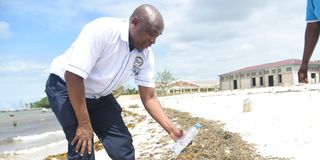World Oceans Day: Kenyan Coastline still under exploited

Kenya Marine and Fisheries Research Institute (KMFRI) Director General Prof. James Njiru holding a water plastic bottle at the Gazi Beach front as Kenya mark the World Ocean Day.
Kenya’s coastal exclusive economic zone remains unexploited, with only less than 10 per cent of fish being harvested.
According to Kenya Marine and Fisheries Research Institute (Kemfri), only 26,000 metric tonnes of fish is harvested in the Indian Ocean annually, with most of the fish consumed being supplied from Lake Victoria.
Kemfri Director General James Njiru said despite Indian Ocean having more than ten commercial species, there is little being harvested in the 142,400 square kilometer zone.
“Currently, we are earning about Sh5 billion from fish in the Indian Ocean but if well harnessed, we can generate more than Sh50 billion only from the Kenyan coastline,” said Prof Njiru.
Speaking in Gasi, Kwale County while commemorating the World Oceans Day, Prof Njiru said Lake Victoria remains the main source of fish in the country, with about 120,000 metric tonnes of fish being harvested annually from the fresh water lake.
“Kemfri is currently conducting fish stock analsysis and its preliminary report indicates that with only one species from Lake Victoria, it still produces the largest catch in the country, hence we need to invest more in the Indian Ocean to increase our fish catch, considering there are more species in the ocean,” said Prof Njiru.
He added, “With the rehabilitation of fish landing site in Liwatoni, Mombasa, it will motivate more to indulge in fishing activities.”
Currently, Kenya has no expertise in deep-sea fishing and has to employ personnel from outside the country and hire foreign vessels to do deep sea fishing in the Indian Ocean, which has remained untapped.
In an earlier interview with the Agriculture and Fisheries Cabinet Secretary Peter Munya, the government said it had allocated Sh5 billion, out of the Sh12 billion, to the ministry’s total budget which will be used to upgrade fisheries facilities and repossess all landing sites to boost fish production.
Already, the government is refurbishing and modernising fish landing sites in Vanga, Kibuyuni and Gazi in Kwale County, and Ngomeni and kichwa cha Kati in Kilifi, which were meant to feed the Liwatoni Fisheries Complex with fish stock. But the project is now in a limbo.
According to Food and Agricultural Organisation (Fao), Kenya’s marine and coastal waters’ maximum sustainable yield is estimated at between 150,000 and 300,000 metric tons, but much less than that is harvested because of infrastructural limitations and inappropriate fishing craft and gear.
Under the country’s blue economy development strategy planned through 2030, Kenya is inviting private investors to partner with the government in developing relevant fishing infrastructure and support small and medium-sized fishing companies to modernise their operations.





